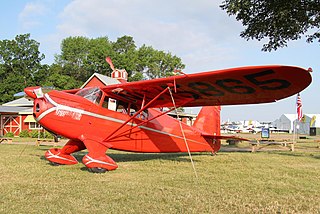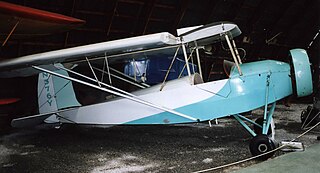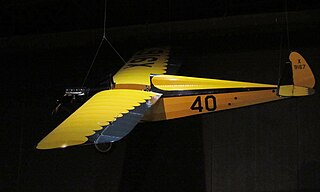
The Flying Flea is a large family of light homebuilt aircraft first flown in 1933.

PZL.26 was a Polish sports plane built in 1934 in the PZL works. Ordered by the Ministry of Defence, it was specifically designed for the upcoming Challenge 1934 International Touring Aircraft Contest.

The Arrow Sport was a two-seat sporting biplane aircraft built in the United States in the 1920s and 1930s.

The Arrow Model F or the Arrow Sport V-8 was a two-seat low-wing braced monoplane aircraft built in the United States between 1934 and 1938. It was built originally to a request by the US Bureau of Air Commerce to investigate the feasibility of using automobile engines to power aircraft. Accordingly, the Model F was fitted with a modified Ford V8 engine. Like the Arrow Sport before it, the Model F seated its pilot and passenger side-by-side in an open cockpit and was marketed for $1500.

The Bellanca 28-92 Trimotor was a racing aircraft built to compete in the Istres-Damascus-Paris Air Race of 1937, and was paid for by popular subscription in Romania. Christened Alba Julia it was piloted by Captain Alexander Papana of the Romanian Air Force.

The Fairchild 22 Model C7 was an American two-seat touring or training monoplane designed and built by the Kreider-Reisner division of the Fairchild Aircraft Corporation at Hagerstown, Maryland.

The Heath Parasol is an American single or two seat, open-cockpit, parasol winged, homebuilt monoplane.

The Nieuport-Delage NiD 42 was a fighter aircraft built in France in the early 1920s, the first in a family of designs that would form the backbone of the French fighter force over the next decade.

The Rearwin Speedster was a two-seat, high-wing, sport aircraft produced by Rearwin Airplanes Inc. in the United States in the 1930s.

The Nicolas-Beazley NB-8G is a United States two-seat parasol wing light monoplane that was constructed in the early 1930s.

The Brown B-1 Racer was an American-built small monoplane racing aircraft of the 1930s.

The Brown B-3 was a 1930s American single-seat touring monoplane and air racer built by the Lawrence Brown Aircraft Company. Only one example was eventually built.

The PWS-11 was a Polish aerobatic and trainer aircraft, developed in 1928-1929 by PWS, which remained a prototype.

The Brown B-2 Racer was an American-built small monoplane racing aircraft built in 1934.

The Church Midwing JC-1, a.k.a. Church Mid-Wing Sport, is a midwing racing aircraft designed by James Church using the fuselage of a Heath aircraft.
The Mercury Chic T-2 was a lightweight American parasol wing monoplane designed and built by the Mercury Aircraft Inc. in the late 1920s. Flown for the first time in 1928, about 27 were built, but due to the early 1930s economic depression only 15 were sold, and the rest were scrapped.
The Sheffield Skeeter X-1 is an American single-seat lightweight homebuilt aircraft designed and built by Kenneth Sheffield of Littleton, Colorado. Designed for amateur construction only the prototype was built.

The Nicholas-Beazley Pobjoy Special aka the Nicholas-Beazley Phantom I, aka the Wittman Phantom, aka the Flagg Phantom, aka the Reaver Special was a world record holding air racer of the 1930s

The Wedell-Williams Model 22 was a racing aircraft, two examples of which were built in the United States in the early 1930s by the Wedell-Williams Air Service Corporation. It was one of three early projects by aircraft designer Jimmy Wedell to create a racer and was built specifically to compete in the 1930 All-American Flying Derby from Buffalo to Detroit. It was a braced, low-wing monoplane originally powered by an inline Cirrus engine and equipped with fixed landing gear in large spats.

The Vulcan American Moth Monoplane was an early parasol-wing monoplane developed by the Doyle brothers.


















